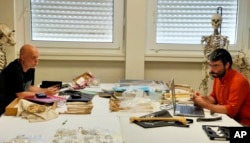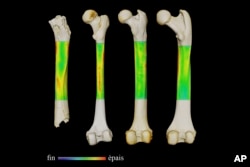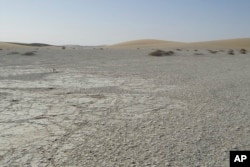Researchers say new examinations of arm and leg fossils support existing evidence that an identified species could be our earliest known ancestor.
The fossil bones were found near a skull that was discovered in 2001 in the African nation of Chad. The scientists who found the skull have suggested that it belonged to a being who walked upright and could be our earliest known ancestor.
Now, researchers say a study involving the arm and leg fossils strengthens that argument. The team looked for signs that the species walked on two feet instead of four. The move toward upright walking is a main division between human and ape development.
The fossil species, called Sahelanthropus tchadensis, walked upright while still being able to climb and move around in trees, the team said.
The species dates back to around seven million years ago, which makes it by far the oldest known human ancestor. That is about a million years older than other early known hominins. Hominin is a group that includes modern humans and species closely related to humans.
Researchers – including scientists at the University of Poitiers in France – closely examined the fossil skull, teeth and jaw. They argued that the animal must have walked on two feet and held its head upright. This argument was based on the placement of a hole in the skull where the spinal cord connects to the brain.
Other experts, however, have not been persuaded, or convinced, by the early evidence.
The latest work includes a thigh bone that was not linked to S. tchadensis at first and went unstudied for years. Other researchers at the French university found the bone in the laboratory’s collection and realized it probably belonged to the fossil species.
Compared to bones from other species, the thigh was linked closer to upright-walking humans than apes who used their feet and arms, the study found. The new findings were recently reported in the publication Nature.
Study co-writer Franck Guy recently spoke about the fossil examinations to reporters. “There is not one feature. There is just a total pattern of features," he said.
The debate over the species is likely to continue. Ashley Hammond is a scientist at the American Museum of Natural History in New York. She said more research is needed to find the being’s rightful place on the evolutionary tree.
“I'm not fully convinced yet," Hammond told The Associated Press. "This could still also be a fossil ape."
Another researcher at the University of Poitiers, Roberto Macchiarelli, examined the thigh bone in the past and decided the species was probably an ape. Looking at the new study, Macchiarelli said he still does not believe the species was a hominin, though it might have walked on two legs at times.
Rick Potts is with the Smithsonian’s National Museum of Natural History and directs the organization’s Human Origins Program. He said the thigh bone puts the species on “better footing” as a possible early human ancestor. But he added that the real confirmation will come down to a common saying in the field: “Show me more fossils.”
I’m Bryan Lynn.
The Associated Press reported this story. Bryan Lynn adapted the report for VOA Learning English.
___________________________________________________________________
Words in This Story
fossil – n. something (such as a leaf, skeleton, or footprint) that is from a plant or animal which lived in ancient times and that you can see in some rocks
species – n. a group of animals or plants that are similar and can produce young animals or plants
feature – n. a typical quality or important part of something
pattern – n. a regular and repeated way in which something happens
evolution – n. a gradual process of change and development
_____________________________________________________________________
What do you think of this story? We want to hear from you. We have a new comment system. Here is how it works:
- 1. Write your comment in the box.
- 2. Under the box, you can see four images for social media accounts. They are for Disqus, Facebook, Twitter and Google.
- 3. Click on one image and a box appears. Enter the login for your social media account. Or you may create one on the Disqus system. It is the blue circle with “D” on it. It is free.
Each time you return to comment on the Learning English site, you can use your account and see your comments and replies to them. Our comment policy is here.













Forum